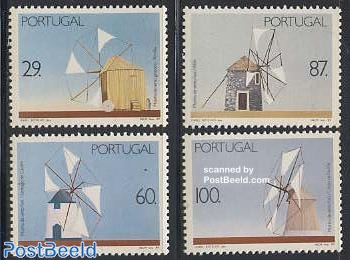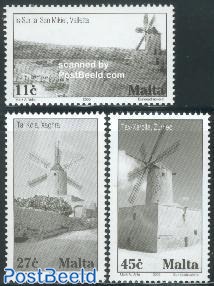

The Deutsche Post (DP) was the state-owned postal and telecommunications monopoly of what was – from 1949 until the reunification of Germany on the 3rd of October 1990 – the German Democratic Republic (East Germany). DP issued the above stamps in 1981. From left to right they show the 1892-built Dabel windmill in the state of Mecklenburg-Vorpommern, the mill (built 1889) at Pahrenz in Saxony, also in Saxony the Dresden-Gohlis windmill (1828) and the mill at Ballstadt in the state of Thuringia.

Two stamps from Lithuania (1999) showing a boarded clay windmill at Melniai and a red-brick windmill in the town of Pumpenai.

The distinctive designs of the five 1980 U.S.A. windmill stamps above reflect the evolution of windmills in America – from ideas imported from Holland to the classic American wind machine of the Southwest United States (far right). Featured are the Robertson windmill (built 1720) in Williamsburg Virginia that was built by early English settlers, three windmills of the smock variety – Rhode Island (1790), Cape Cod (Massachusetts 1793), the Dutch mill at Batavia (Illinois 1860) – and the modern Texas-style “wind-engine”(1890). This was the first time a US stamp booklet contained more than one stamp design on a topical theme.

Amazingly, the Caribbean Island of Barbados once had the second highest number of windmills per square mail of any country in the world. They were instrumental in helping establish the sugar industry on the island. Once there were more than 500 windmills on the island but nowadays there is only one left in working order and that is at Morgan Lewis, St. Andrew (stamp on the right). It is one of only two working sugar windmills in the world today. The other three stamps show the remains of the Graeme Hall mill at Christ Church, the Balls mill Christ Church and the St.Nicholas Abbey tower mill.

For this fine set from Ukraine in 2012 the block selvedges are artistically decorated with historic scenes plus text on the top selvedge in Ukrainian and English: “Вітряки України (“Windmills of Ukraine”).

Great Britain set from 2017 with photos of wind and water mills from England, Scotland, Wales and Northern Island. They show six of the UK’s finest surviving wind and water mills, which between them ground grain, processed flint and produced cloth.

Portuguese windmills in Ansiao, Afife, Santiago do Cacem and Caldas da Rainha.

An unusual black and white set from Malta in 2003. On the 11c. stamp is the Tower windmill at St Michael’s Bastion in Valletta, Malta’s capital. Bottom left is the Ta’Kola windmill (built 1725) in the village of Xaghra on the Maltese island Gozo. The 45c. shows the Tax-Xarolla, Zurrieq mill (1724) which is now the only functioning windmill in the islands of Malta and Gozo.
![]()
